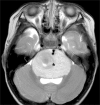Acquired onset of third, fourth, and sixth cranial nerve palsies in children and adolescents
- PMID: 30760897
- PMCID: PMC6707187
- DOI: 10.1038/s41433-019-0353-y
Acquired onset of third, fourth, and sixth cranial nerve palsies in children and adolescents
Abstract
Purpose: To describe the causes of third, fourth, and sixth cranial nerve palsies in children and adolescents.
Methods: In this retrospective case series, a total of 66 patients aged 0-19 years with third, fourth, and sixth cranial nerve palsies seen in strabismus and neuro-ophthalmic practice from 2010 to 2017 were included. Causes of palsies were determined based on clinical assessment, high-resolution magnetic resonance imaging (MRI), and laboratory work-up.
Results: Thirty-five patients had sixth cranial nerve palsy, 14 patients had third cranial nerve palsy (7 partial, 7 complete), 13 patients had fourth cranial nerve palsy, and 4 patients had combined cranial nerve palsies in this study. Neoplasia involving central nervous system was one of the most common causes of third, fourth, and sixth cranial nerve palsies both in children (age: 0-14 years) and adolescents (age: 15-19 years) (20% and 31%, respectively). Overall, neoplasia (23%) was the most common cause of acute third, fourth, and sixth cranial nerve palsies, followed by idiopathic cause (14%), inflammation (11%), and non-aneurysmal vascular contact (11%). Neoplasia was also the most common cause of sixth and third cranial nerve palsies (25% and 29%, respectively). The most common cause of fourth cranial nerve palsy was late decompensation in congenital fourth cranial nerve palsy (46%).
Conclusions: A substantial proportion of pediatric and juvenile patients had serious pathologies for third, fourth, and sixth cranial nerve palsies. If nerve palsies are indicated, prompt diagnosis of etiologies using high-resolution MRI with contrast and laboratory work-up are important for this disease population.
Conflict of interest statement
The authors declare that they have no conflict of interest.
Figures


Similar articles
-
Cause of acquired onset of diplopia due to isolated third, fourth, and sixth cranial nerve palsies in patients aged 20 to 50 years in Korea: A high resolution magnetic resonance imaging study.J Neurol Sci. 2019 Dec 15;407:116546. doi: 10.1016/j.jns.2019.116546. Epub 2019 Oct 19. J Neurol Sci. 2019. PMID: 31669731
-
Paralytic strabismus: third, fourth, and sixth nerve palsy.Neurol Clin. 2010 Aug;28(3):803-33. doi: 10.1016/j.ncl.2010.04.001. Neurol Clin. 2010. PMID: 20638001
-
Idiopathic third and sixth cranial nerve neuritis.Jpn J Ophthalmol. 2019 Jul;63(4):337-343. doi: 10.1007/s10384-019-00666-7. Epub 2019 Apr 20. Jpn J Ophthalmol. 2019. PMID: 31006061
-
Neuro-ophthalmology of eye-movement disorders.Curr Opin Ophthalmol. 1999 Dec;10(6):405-10. doi: 10.1097/00055735-199912000-00007. Curr Opin Ophthalmol. 1999. PMID: 10662245 Review.
-
Palsies of the third, fourth, and sixth cranial nerves.Ophthalmol Clin North Am. 2001 Mar;14(1):169-85, ix. Ophthalmol Clin North Am. 2001. PMID: 11370565 Review.
Cited by
-
Outcomes and Factors Associated with Successful Strabismus Surgery for Abducens Nerve Palsies: A Retrospective Study and Literature Review.Clin Ophthalmol. 2024 Jul 8;18:1945-1958. doi: 10.2147/OPTH.S470050. eCollection 2024. Clin Ophthalmol. 2024. PMID: 39005588 Free PMC article.
-
Multiple Sclerosis Presenting with Sixth Nerve Palsy in a Child.Int Med Case Rep J. 2021 Aug 13;14:545-550. doi: 10.2147/IMCRJ.S320678. eCollection 2021. Int Med Case Rep J. 2021. PMID: 34413685 Free PMC article.
-
Neuro-pediatric emergencies: clinical profile and outcomes.J Med Life. 2024 Apr;17(4):432-441. doi: 10.25122/jml-2023-0476. J Med Life. 2024. PMID: 39071508 Free PMC article.
-
Imaging the brain: diagnosis aided by structural features on neuroimaging studies.Eye (Lond). 2024 Aug;38(12):2380-2391. doi: 10.1038/s41433-024-03142-w. Epub 2024 May 23. Eye (Lond). 2024. PMID: 38783084 Free PMC article. Review.
-
Idiopathic unilateral complete oculomotor nerve palsy: a case report of diagnostic quandary.Ann Med Surg (Lond). 2024 Aug 30;86(10):6251-6256. doi: 10.1097/MS9.0000000000002514. eCollection 2024 Oct. Ann Med Surg (Lond). 2024. PMID: 39359775 Free PMC article.
References
-
- Aroichane M, Repka MX. Outcome of sixth nerve palsy or paresis in young children. J Pediatr Ophthalmol Strabismus. 1995;32:152–6. - PubMed
MeSH terms
LinkOut - more resources
Full Text Sources
Medical

